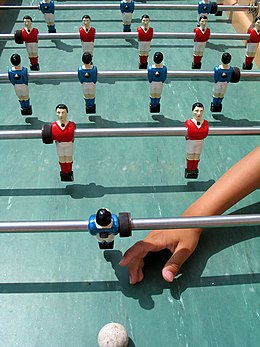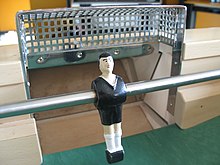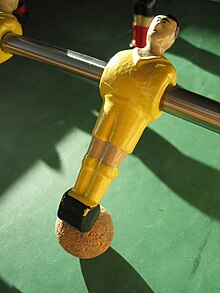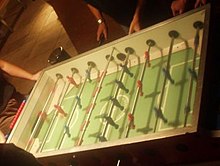Table football

Table football, also known as foosball, fooseball, foozeball, fusball, fuseball, table soccer, metegol, taca-taca, futbolín, totó, pebolim, gits, footine, baby-foot, kicker, is a table-top sport that is based on association football (soccer).
History
Although patents for similar games may exist from as far back as the 1890s, the game of Table Football as we know it today was first invented and patented in 1923 (UK patent no. 205,991 application: dated 14 October 1922 and accepted: 1 November 1923) by an Englishman by the name of Harold S. Thornton of North London (1895-1951).
The concept was conceived after Harold had been to a Spurs football match (he was an avid supporter). He wanted to provide a game that replicated football that could be played at home. The inspiration came from a box of matches; by laying the matches across the box he had formed the basis of his game.
His uncle (United States resident Louis P. Thornton, who lived in Portland Oregon) visited Harold and took the inspiration back to the States where it was patented in 1927 (United States Patent Office No. 1,615,491). The patent eventually expired.
The Galician Alexandre de Fisterra (Galicia is the northwestern area of Spain) thought of making a form of soccer that would be fun for children who could not play traditional soccer. He commissioned Francisco Javier Altuna to create this form of recreational game, which as a result was supported by patenting during 1937. Then, it would be a Galician invention.
In 2002, the International Table Soccer Federation (ITSF) was established in France with the mission of promoting the sport of Table Soccer as an organizing sports body, regulating international competitions, and establishing the game with the International Olympic Committee (IOC) and General Association of International Sport Federation (GAISF).
The game

To begin the game, the ball is served through a hole at the side of the table, or simply placed by hand at the feet of a figure in the center of the table. The initial serving side is decided with by coin toss. Players attempt to use figures mounted on rotating bars to kick the ball into the opposing goal. Expert players have been known to move balls at speeds up to 56 kmh (35 mph) in competition.[citation needed]

Rules consider "360-degree shots" or "spinning" (using the palm of the hand to swiftly spin the bar all around, instead of using wrist strokes to kick the ball with a bar-mounted figure) to be illegal. However, shots short of a full 360-degree rotation are legal.
The winner is determined when one team scores a predetermined number of goals, typically five, ten, or eleven in competition. When playing Bonzini competitions the target numbers of goal is seven.
Table football tables can vary in size, but a typical table is about 120 cm (4 ft) long and 61 cm (2 ft) wide. The table usually contains 8 rows of foos men, which are plastic, metal, wooden, or sometimes carbon-fibre figures mounted on horizontal metal bars. Each team of 1, 2, or 3 human players controls 4 rows of foos men.
The arrangement is standard. Looking from left to right on one side of the table, the configuration is as follows:
| Row 1 | Goalkeeper | 1 foosman (sometimes 2 or 3) |
| Row 2 | Defense | 2 foosmen (sometimes 3) |
| Row 3 | Opponent's attack | 3 foosmen (sometimes 2) |
| Row 4 | Midfield | 5 foosmen (sometimes 4 or 6) |
| Row 5 | Opponent's midfield | 5 foosmen (sometimes 4 or 6) |
| Row 6 | Attack | 3 foosmen (sometimes 2) |
| Row 7 | Opponent's defense | 2 foosmen (sometimes 3) |
| Row 8 | Opponent's goalkeeper | 1 foosman (sometimes 2 or 3) |
Table football can also be played with four people in "doubles" style, in which there are teams of two people on either side. In this scenario, one player can control the two defensive rows and the other team member uses the midfield and attack rows. In informal matches, three or four players per side are also common.
Competition

Table football is often played for fun in pubs, bars, workplaces, schools, and clubs with few rules. Table football is also played in official competitions organized by a number of national organizations, with highly evolved rules and regulations. Organized competition can be traced back to the 1940s and 1950s in Europe. But the professional tours and bigtime money events began when the founding father of modern professional table soccer, Lee Peppard of Seattle, Washington, United States announced a "quarter million dollar tour" in 1975. Peppard went on to award several million dollars in prize monies, and, ever since his Tournament Soccer Organization went out of business in 1981, several organizations and promoters have continued holding large purse professional table soccer events worldwide. The ITSF regulates International events including the yearly World Championships and the World Cup held to coincide with the FIFA World Cup every four years. In 2006, Austria, Germany and Belgium took the Gold, Silver and Bronze respectively.
Tables


A vast number of different tables exist. The table brands used on the world tour and official ITSF tournaments are "French-style" Bonzini, "American-style" Tornado, "Italian-style" Roberto Sport and Garlando, "German-style" Tecball. Other major brands include Kicker, Rosengart, Jupiter Goldstar, Eurosoccer, Löwen-Soccer, Warrior, Lehmacher, Leonhart, and Smoby. There was also a 7-meter table created by artist Maurizio Cattelan for a piece called Stadium. It takes 11 players to a side. Another unique table football set is the Opus Table created by the Elevenforty company. Each table is hand-crafted, and each foosman is made to resemble his on-field counterpart.
Differences in the table types have great influence on the playing styles. Most tables have one goalie whose movements are restricted to the goal area. On some of these tables the goalie becomes unable to get the ball once it is stuck out of reach in the corner; others have sloped corners to return the ball. Other tables have three goalies, one in the center and one in each corner to reach the ball so sloped corners are not needed. Another major difference is found in the balls, which can be made of cork, plastic, wood or even marble and metal, varying the speed of shots a great deal, as well as the "grip" between the man and the ball.
Names
The most common English names are table football, footzy, bar football and foosball, though table soccer is also used. Among French-style players it is known as baby-foot [1]. Foosball can also be spelled "foozball", "foozeball", "fooseball" and (though rarely) "fuseball".
Here is a list of its name in several countries:
| Region | Name |
| Arab countries | widely known as كرة فتل (Korah Fatel) in Arabic, which means "rolling football." It is also called بابي فت (baby-foot) in some Arabic regions, including Palestine and Jordan. |
| Argentina | metegol |
| Austria | Wuzler (also spelled Wuzzler), playing table football is called wuzeln |
| Belgium | Kicker (after the brand of foosball tables) |
| Bolivia | Futbolín |
| Brazil | Pebolim or totó |
| Bulgaria | Futbol na masa ("table football"), also djagi |
| Canada | usually foosball, but often referred to as jitz which initiated from the Italian word "gitoni" which means foosball or table soccer. People called it gitz for short and spelled it "jitz" for elegance. In the province of Quebec, it is known as baby-foot. |
| Chile | Taca-Taca |
| China | 桌上足球 (table football) |
| Costa Rica | Futbolín |
| Croatia | Stolni nogomet |
| Czech Republic | fotbálek, regionally (mostly in Moravia) also kalčo (probably from Italian calcetto?) |
| Denmark | Bordfodbold (lit. "table football") |
| Estonia | Lauajalgpall |
| France | Baby-foot or Babyfoot |
| Germany | Table football is commonly known as Tischfußball, Tischkicker or Kicker in German.[1] |
| Greece | Ποδοσφαιράκι, σουβλάκια |
| Guatemala | futío |
| Hungary | Csocsó |
| Iceland | Fótboltaspil |
| India | Fusball |
| Iran | فوتبال دستی (handheld football) |
| Israel | כדורגל שולחן (table football) |
| Italy | calcio balilla, bigliardino or biliardino (from "biglia", little ball) or even calcetto (less frequent, since "calcetto" is commonly used to indicate Five-a-side football), and in particular areas fubalino |
| Latvia | Galda futbols |
| Lithuania | Stalo futbolas |
| Malta | Ċomba |
| México | futbolito |
| Netherlands | Tafelvoetbal |
| Other Spanish-speaking countries | In some other Spanish-speaking countries the terms fútbol de mesa or futbolito are used, although the latter might also refer to football played on a smaller field. |
| Pakistan | widely known as پٹّی (patti) in Urdu, which means "pitch or strip" |
| Peru | fulbito de mesa or futbolín |
| Poland | piłkarzyki, which roughly translated means "small football players" |
| Portugal | Matraquilhos or matrecos |
| Romania | Fusbal or Fotbal de masa |
| Russia | кикер or настольный футбол |
| Serbia | Stoni fudbal |
| Slovenia | Ročni nogomet |
| Slovakia | Kalčeto |
| Spain, Colombia and Costa Rica | futbolín (In Spanish autonomy of Galicia, where is spoken a language linked with Portuguese, it's also called matraquiños and ferriños) |
| Taiwan | 手足球(桌上足球) |
| Turkey | Langırt |
| United States | foosball |
| Uruguay | futbolito |
| Venezuela | Futbolín |
| Zimbabwe | Slug |
| South Africa | Tata box/Ma tata |
Robots
Robots designed to play table soccer by roboticists at the University of Freiburg are claimed to be able to beat 85 percent of casual players. They use a camera from below a transparent table base to track the ball, and an electronic control system to control high torque motors to rotate and move the foosmen. Currently an expert player can beat the robot 10 games to 1. [2]. Another table football robot, Foosbot, is claimed to have never been beaten by a human, but has not been tested against expert players[citation needed]. Yet another table football robot is under development by two students at the Technical University of Denmark. The robot uses a camera mounted above an ordinary table. [3].
In popular culture
This article contains a list of miscellaneous information. (June 2008) |
- In the 1998 Adam Sandler movie The Waterboy, Kathy Bates's character as Bobby Boucher's (Sandler) momma often refers to American football as fool's ball by mistake.
- Table football tables have figured prominently in a number of movies such as Foos: Be the Greatest (2006, USA) and Longshot (1981, USA).
- In an episode of Mystery Science Theater 3000, Dr. Forrester and Frank told how they took a table football table, caulked it, filled it with water, and turned it into a water polo game.
- In the TV show House, Dr. House and Dr. Wilson are often seen playing the game in the doctor's lounge.
- In the TV series Zoey 101, characters are often seen playing the game in the PCA lounge.
- The German movie Absolute Giganten features an interestingly filmed game.
- The characters Joey Tribbiani and Chandler Bing from the Friends TV show (1994-2004, USA) often play table football. The sitcom featured a Dynamo table in earlier seasons, and later a Tornado (Valley) brand table, each of which were central to many episodes. It was destroyed in The Last One by Monica, when Joey's pets (a chick and duck) are stuck inside.
- Table football figures prominently as a Scottish bar sport in the short story "Kingdom of Fife" by Irvine Welsh.
- In the award-winning Italian movie Il Postino, which is set in the 1950s, the eponymous character of Mario Ruoppolo fell in love at first sight with Beatrice Russo while playing table football.
See also
- List of world Table football champions
- Air hockey
- Cue sports
- Button football
- Pfitschigogerl
- Sports table football
- Table hockey
- Table tennis
References
- ^ a b BFA - Table Football
- ^ Article from New Scientist
- ^ Automated table football table project home page
External links
International and national federations
- International Table Soccer Federation
- Argentine Table Soccer Association
- Australian Foosball Federation
- Brazilian "Pebolim" Federation
- British Foosball Association
- Canadian foosball event & tournament listings
- CFO, Czech Foosball Organization
- Danish table-soccer federation
- Dutch Foosball Federation
- French table-soccer federation
- German table-soccer federation
- Hungarian Table Soccer Federation
- Italian "Calcio Balilla" federation
- Polish Table Soccer Federation
- R.T.S.F., Russian Table Soccer Federation
- United States Table Soccer Federation
- Table football pictures
- Foosball Game Table Differences
- New York City Foosball
- Costa Rican Foosball
- Bulgarian Table Soccer Federation
- Lithuanian Table Soccer Federation
- Foosball Tactics
- Portuguese Table Football Tournment in Honor of its inventor, Alejandro Finisterre
